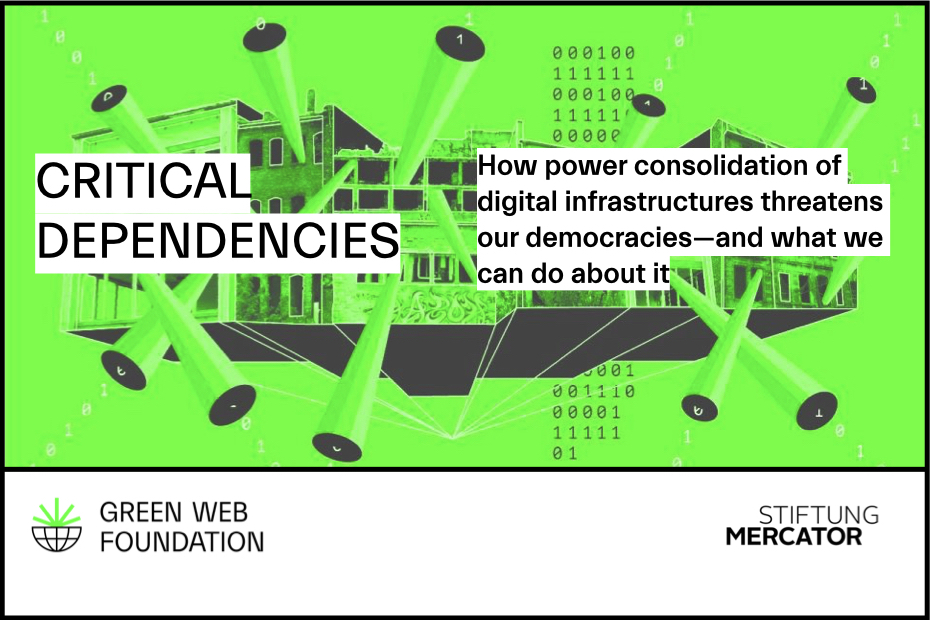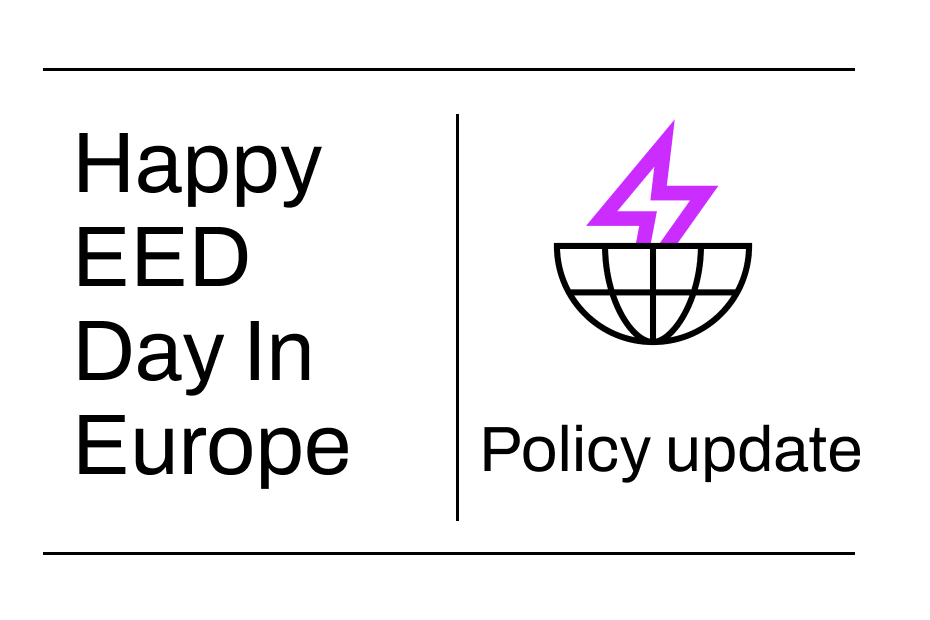We’re proud to share our report Critical Dependencies: How power consolidation of digital infrastructures threatens democracies—and what we can do about it.
It’s written to help funders who want to better understand how to strengthen the public’s interest in digital infrastructures at a systemic rather than symptomatic level. The report summarizes harms caused by unhealthy dependencies and recommends how to challenge power consolidation and foster meaningful alternatives.
We are at an inflection point in digital infrastructures. There is much conversation about the unprecedented speed and scale of our computational future. Significant investments are being made, especially as part of private and national efforts to “win the AI arms race.” Meanwhile, more data is becoming available about the harms of these systems. No one has perfect knowledge of the situation, and in some instances, information is being intentionally obscured or distorted. Amidst the confusion and scramble, well-resourced players are seizing strategic footholds and advancing their cause. This moment is called the “fog of enactment.”
Some of the wealthiest companies in the world spend billions in lobbying, sponsoring research, obscuring their emissions and building out parallel energy and digital infrastructures to further secure their market positions.
Meanwhile, deliberative democratic processes take time and resources. The public and, at times, democratically elected officials lack access to the data and decision-making about our digital futures. Furthermore, the technical expertise to evaluate these tradeoffs from a public interest perspective is structurally under-resourced.
This report seeks to call out these maneuvers and recommend pathways for funding in the public’s interest with a focus on the energy and climate impacts of digital infrastructures and harms caused by current ownership models. We call for actions that are ambitious, collaborative and intersectional to help redistribute more power to the public interest and to just and sustainable digital futures.
Read the highlights below.
Insights
We find that:
- Digital resources — or the capacity to process, store and transfer data — are the foundation of our digital economy. The entities best positioned to generate digital resources profit the most from the growth of the digital realm. Such companies use bundling, regulatory capture and inoperability to run closed markets which are not transparent and lock-in customers. They capitalize on and intensify society’s growing dependencies on digital resources as they fuel demand for digitalization and high intensity computing such as AI systems. This dynamic further consolidates their market power, making it difficult for new entrants and enabling the same companies to expand their control over more sectors such as energy.
- The goals of democratic societies are not the same as the goals of the wealthiest companies on earth. While democratic societies need and want digital products and services, such as meaningful connectivity, this is not the core business model of these companies. A closed digital infrastructure market intensifies inequalities and stifles competition and innovation while under-delivering on the basic services society needs.
- Many digital infrastructures suffer from a democratic deficit. Impacted communities are alienated from the information and decision-making process about the costs and benefits of digital infrastructures. Nevertheless, they are made to bear the burden of their harms.
- Democratic participation should help determine the purpose digital infrastructures and how resources are allocated to them. This practice could address the democratic deficit of our current ownership models. However, this requires alignment and shared rules across territories, so that one community’s victory does not displace the conflict and shift the harms to another community. The community energy sector can provide useful patterns.
- Funding is vastly asymmetrical and current fiscal policies entrench these disparities. The richest companies in the world are buying and building the energy and computer systems at unprecedented rates with state subsidies.4 Meanwhile civil society scrambles to find scarce resources to articulate and mitigate harms. Foundational democratic commitments as deprioritized, such as meaningful internet connectivity and emissions reduction targets for the digital sector, in favor of technological hype. This leaves a resourcing gap for deep, sustained and intersectional public interest infrastructure.
Recommendations
In the report, we recommend:
- Diversify the production of digital resources by strengthening competition law, interoperability, and unbundling cloud providers. Digital resources form the baseline unit of the digital economy, and the major cloud providers are the main producers of these digital resources. In Europe, almost ¾ of the overall cloud computing market is controlled by three companies: Microsoft Azure, Google Cloud, and Amazon AWS. These companies, headquartered in the United States, undertake extensive maneuvers to reduce their taxes in the European countries in which they operate.
Although they face multiple anti-competition cases, these companies generate ample cashflow thanks to their vertical integration and core business models (advertising, licensing and e-commerce). This profit in turns enables them to build more infrastructure. By controlling the infrastructure that underpins the digital economy, they position themselves to uniquely profit from digitalization—be it societally useful or not. The Digital Markets Act seeks to address some monopolistic practices. However, the integrated infrastructure business units (‘their cloud business’) are outside the scope of this regulation and more work is needed to break up this power concentration. - Advocate for digital infrastructure that serves the public good and operates within planetary boundaries. Current projections of AI growth show that energy demand for high intensity computation will outstrip what national decarbonizing grids can provide. All major digital infrastructure operators purchase significant renewable energy and add new generation to the grid. However, this new generation is largely meeting their own private new demand rather than decarbonizing the grid for pre-existing demand. This gap in renewable energy generation means that households and other sectors have to rely on fossil fuels while digital infrastructures are prioritized with green energy. National digital strategies should address how digital infrastructures will operate within planetary boundaries while also providing universal basic digital services, such as meaningful connectivity, for all who want it. Providers of digital infrastructure should face a burden of proof that the resources going to their systems are benefiting the public good and meeting environmental and climate targets.
Here are opportunities to connect with research exploring how digital technologies can reduce harm to environmental ecosystems and help cut emissions to hit life-preserving climate targets. Nevertheless, these approaches must be grounded in the realities of the natural resources available, include democratic processes and oversight and move away from false solutions and green extractivism so as not to perpetuate, perhaps inadvertently, harm towards frontline communities. - Defend and support independent research into the harms of digital infrastructure companies. Tech companies often obstruct and undermine the public’s knowledge of their operations and impacts. For example, they forbid access to researchers who try to work independently or increasingly use lawsuits and other forms of legal harassment to intimidate them. Large digital infrastructure companies are notorious for not providing information that exposes their cost structure. Transparency is an important step. The European Corporate Sustainability Reporting Directive (CSRD) will help gain access to data about the finances and sustainability of companies. Furthermore, an attempt was made by the EU within the Energy Efficiency Directive to implement minimal transparency efforts. But this law does not guarantee public access to the environmental impact.
Yet much more is needed on top of that transparency. From human- and machine-readable ways of navigating public reporting data to stronger enforcement and compliance, as well as independent research to contextualize and deepen these results. - Strengthen democratic participation in decision-making about digital infrastructures. Democracy is sometimes described as a muscle: if it is not exercised, then it atrophies. Citizens and impacted communities are often shut out of decision-making processes about where and how these infrastructures are built and maintained, who benefits from them and who carries the burden of harms. To address the democratic deficit in digital infrastructures, communities must be involved in meaningful ways to foster their digital self-determination and ensure their voices are heard as a counterweight to industry lobbying. The research institute AI Now suggests that companies be required to affirmatively demonstrate that they are not doing harm as opposed to asking the public and regulators to continually investigate, identify, and find solutions for harms after they occur.17 In the rooms where decisions are made about digital infrastructures, we must ensure there is public interest representation. This requires sustained funding and cultivating a community of practice to use those moments effectively.
Other important approaches include strengthening the multistakeholder model in spaces such as the UN Internet Governance Forum, which is currently under threat from authoritarian control and is shutting out civil society, and fostering worker representation on companies’ governing bodies. - Invest in digital self-determination and alternative imaginaries. What does it look like if digital resources are generated and stewarded by communities rather than corporations? Central to democracy is choice — the agency and the ability to make decisions about one’s life. In democratic societies, our digital infrastructures should support our self-determination, even if the decision is to opt out of these infrastructures. Increasingly, our choice of digital infrastructure is limited, let alone opting out of them completely. It is critical to have the possibility of choosing and for these alternatives to be viable. There must be genuine choice than, for example, choosing between two nearly identical hyperscalers. Public interest investment into imagining and building these alternatives is critical.
Other sectors have established patterns for community ownership. Successful examples include community energy where for the last 30-40 years, growth in energy in Europe has come from community energy projects, led by countries such as Germany and Denmark.
Monopolistic digital conglomerates are not special — just new. There are patterns from other eras and other sectors for addressing the lack of democratic participation and public interest representation in infrastructures. But these changes won’t happen without proactive funding. Philanthropic funding is well positioned to resource a deep bench of people working on these issues in a sustained way so that there is the capacity to challenge and change the systems.
Public interest policy moves beyond a narrow focus on legislative and policy levers and embraces a broad-based theory of change. Funders must bring together more groups trying to climb the mountain from different sides. Unlike the private sector, philanthropy can help identify alliances across social movements and advocate for solutions that co-benefit impacted communities and the planet. And in comparisons to government funding, philanthropy can be more agile and intersectional. Regardless of funding mechanism, the scale and urgency of the crises call for investments must be ambitious, intersectional and towards regeneration.
Thank you to Stiftung Mercator for commissioning this work and many fantastic organizations for your research and input. Image credit: Anton Grabolle / Better Images of AI / AI Architecture / Licenced by CC-BY 4.0
If you’d like to learn more or explore how to apply these recommendations to your context, please get in touch!



